
Okapi: The shy forest dwellers of central Africa

![]()
The mysterious and enigmatic okapi is one of the oldest mammals on Earth, but it has only been known to the western world since the early 20th century.
Covered in unusual markings on their rump and legs, okapi are elusive, shy and gentle, and nearly impossible to observe in the wild due to their secretive nature.
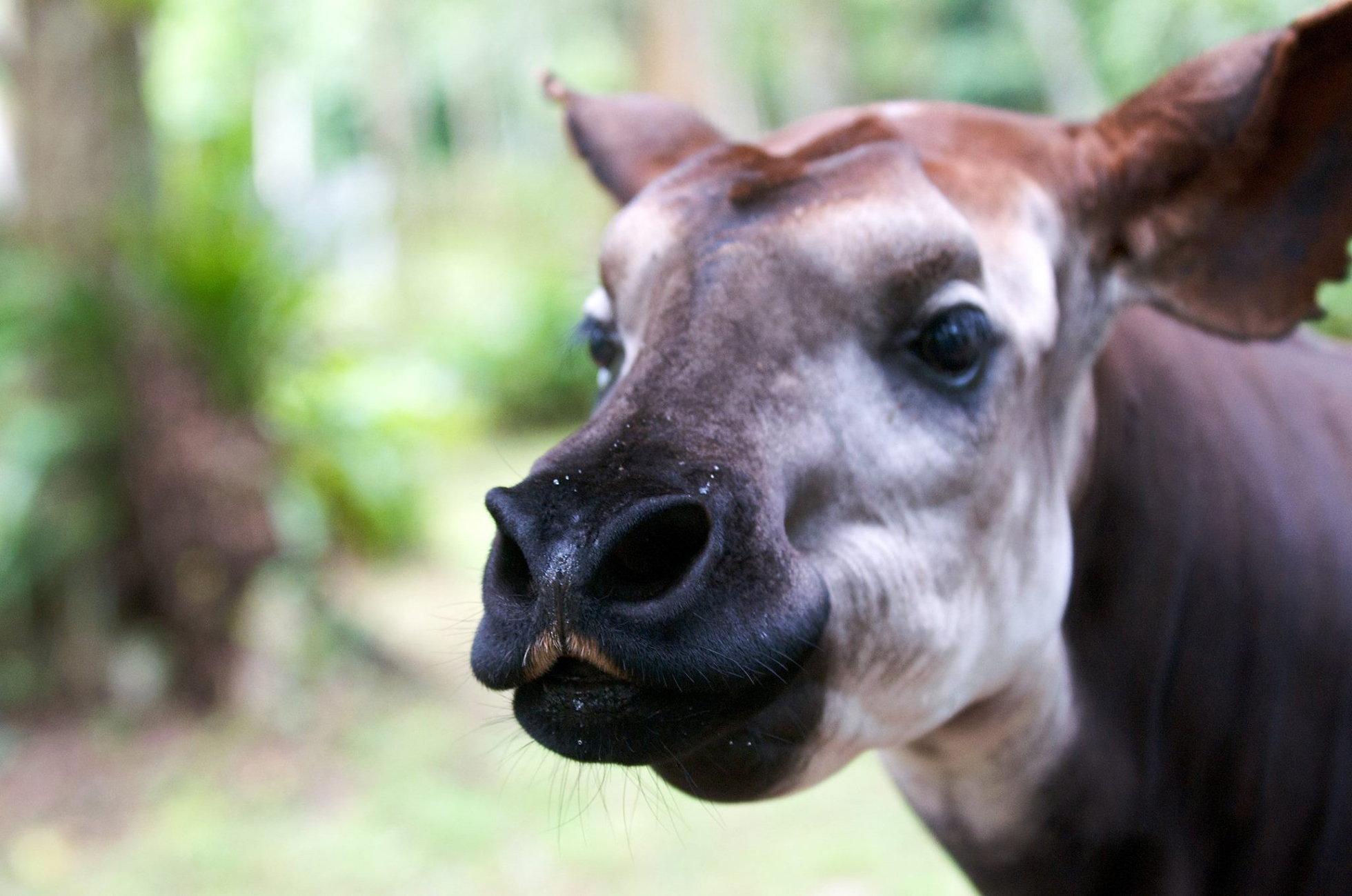
The Okapi Conservation Project (OCP) has been steadfastly protecting okapi in the Democratic Republic of Congo long before the country became known as such. Founded in 1987, when the country was called Zaire and under the ruling of Mobutu Sese Seko, the Project struck up a Contract of Collaboration with the Institut Congolais pour la Conservation de la Nature (ICCN) with the agreement to protect the okapi and its habitat through wildlife protection, community assistance and conservation education.
Just five years later in 1992, the OCP, alongside ICCN, the Zaire government and many other partner NGOs, helped develop the Okapi Wildlife Reserve – a nearly 14,000 km² World Heritage Site in the Ituri Forest in the northeast of the DR Congo – dedicated to protecting the largest populations of okapi, forest elephants and chimpanzees.
Once a tourist hotspot under Belgian rule until 1961 when DR Congo gained independence, the town of Epulu is centrally located inside the protected area and where the Okapi Conservation Project is based, along with the ICCN headquarters for the Okapi Wildlife Reserve.
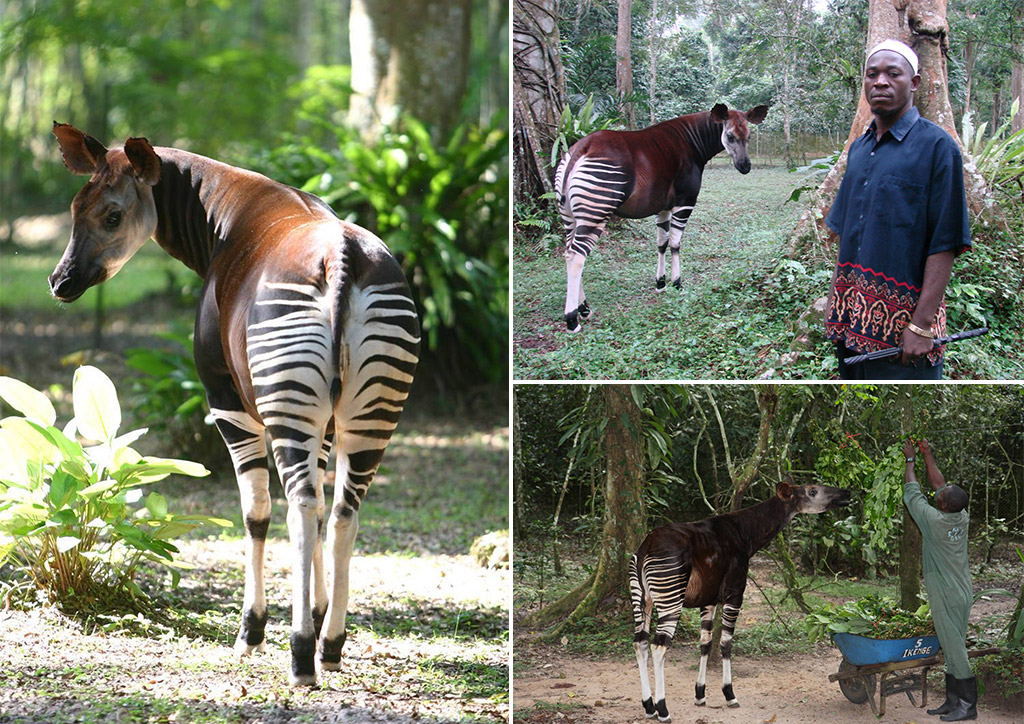
In 2016, the OCP launched a camera trap program aptly named ‘Team Okapi’ consisting of a group of ICCN rangers, local people and Pygmy guides to place camera traps in strategic locations around the reserve to understand what species exist nearby, the number of individuals, and any other natural history or interesting knowledge gained from capturing stills and video clips from the motion-sensing cameras.
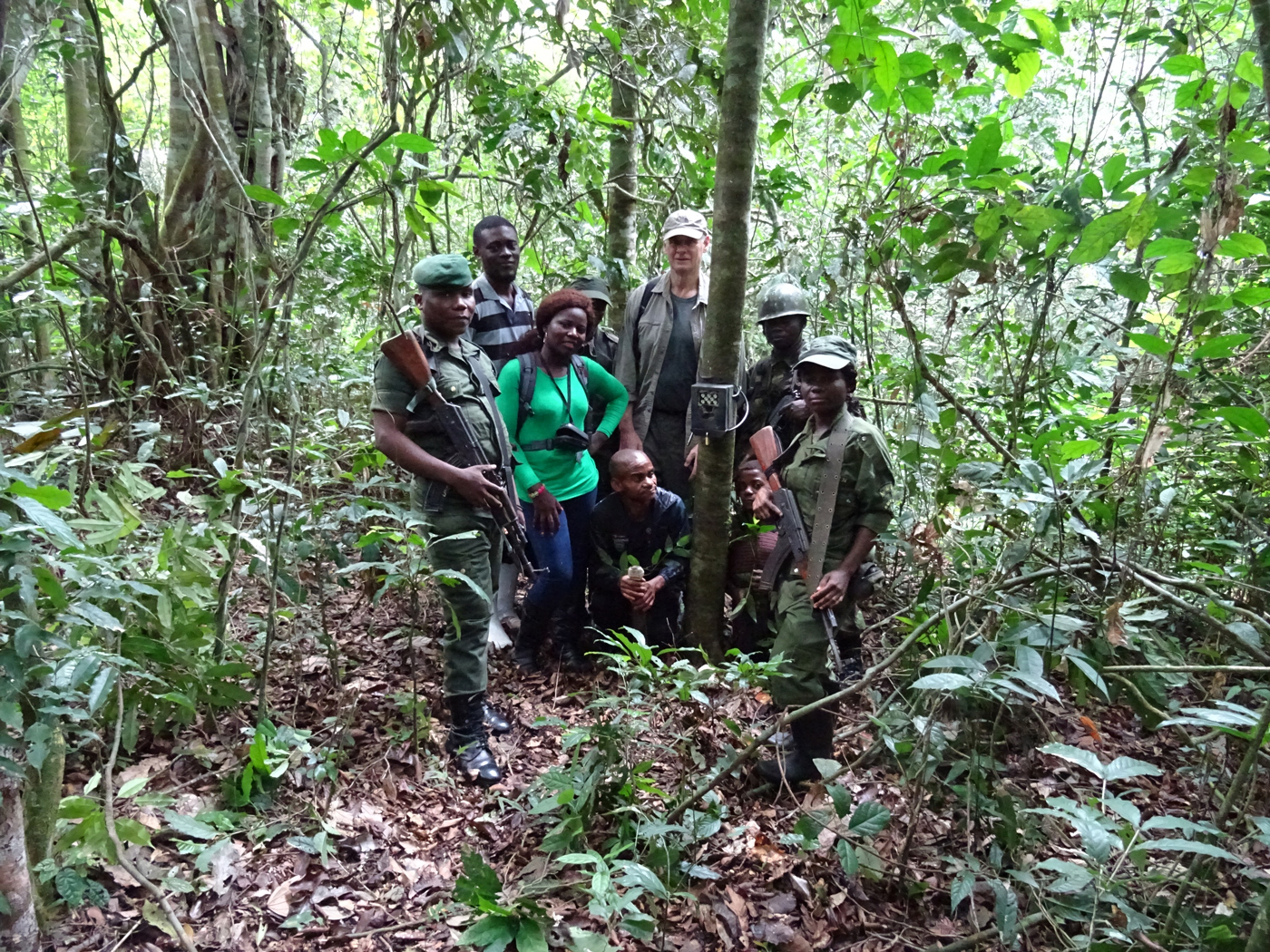
It is possible to identify individual okapi based on their markings, as each okapi has a unique pattern, like human fingerprints. Camera trapping has the potential to be very useful in determining okapi population size and enhancing current population estimates, as before camera traps the populations were estimated using dung counts.
So far, the results have been fantastic! After a few trial-runs of learning how to use the cameras, Team Okapi was able to capture the first-ever footage of an okapi feeding in the Okapi Wildlife Reserve, and more recently, the first-ever footage of an okapi calf in the wild.

We believe this calf to be the offspring of a pregnant female that was captured on film in December, and that she gave birth immediately following the footage – and a mere two months later the mother and her calf casually strolled past the camera, much to the delight of the team.
See the first-ever footage to be taken of a wild okapi calf below (© Okapi Conservation Project)
The okapi’s life and unique behaviours revolve around avoiding their only natural predator – leopards. As such, when a female gives birth, the calf finds a safe place to nest and remains there for roughly two months while the mother goes off to feed, ensuring her scent stays away from the youngster.
The calf only leaves the nest to feed when the mother calls using infrasonic sound at a level that both humans and leopards cannot hear. After those initial eight or so weeks, the calf begins following the mother, continuing to nurse. This unique behaviour may explain why we did not see the calf for the first few months.
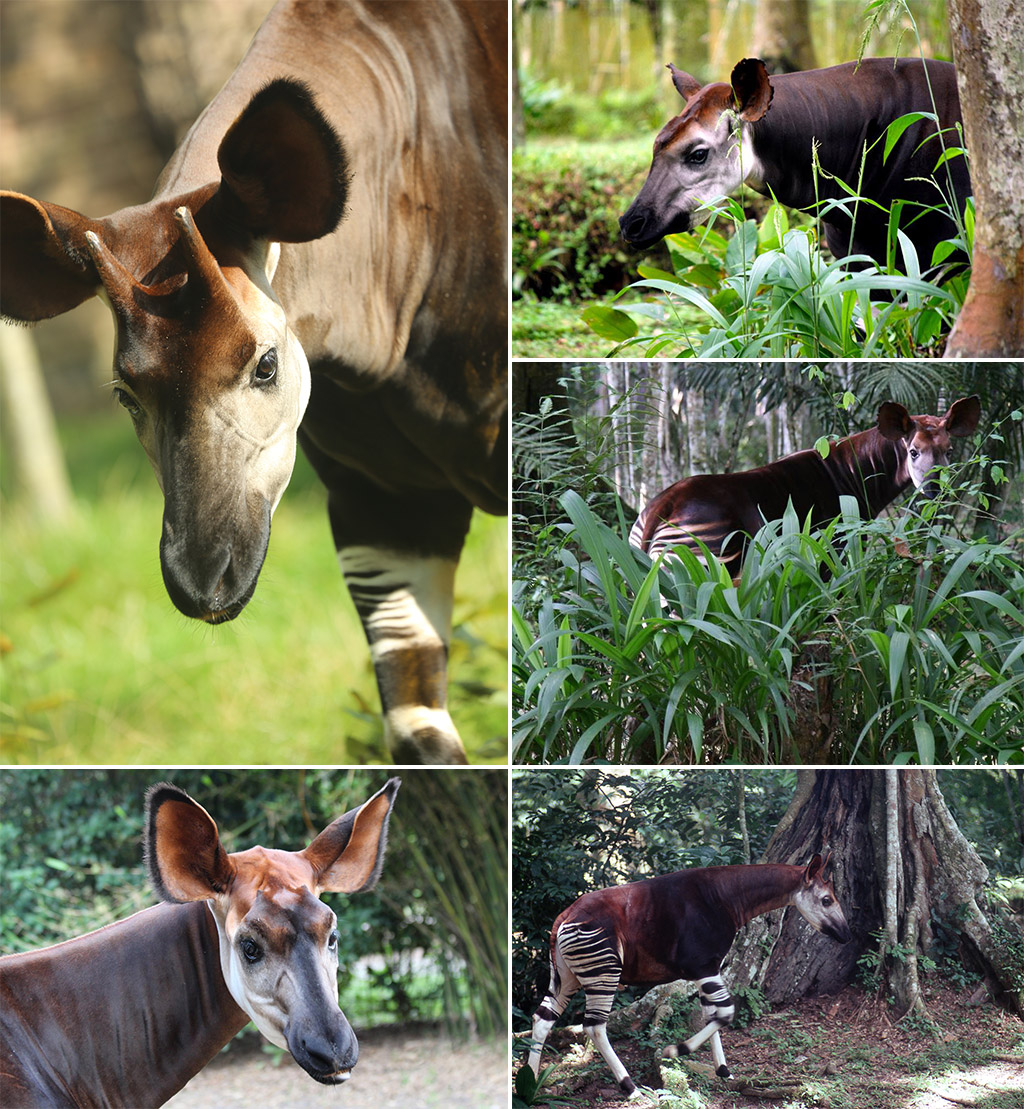
Brief introduction TO the OKAPI
Extracted from IUCN & the Giraffe & Okapi Specialist Group
The okapi (Okapia johnstoni), also known as the forest giraffe, Congolese giraffe or zebra giraffe, is an ungulate native to the central and northeastern tropical rainforest of DR Congo. Although superficially resembling a cross between a zebra and an antelope, the okapi is, in fact, the closest living relative of the giraffe; together they make up the group known as the giraffids.
An okapi’s short, oily fur acts as waterproofing in the damp rainforest environment. Their distinctive stripes are thought to act as camouflage by breaking up the outline of the body in the light and shade of the forest understory and are unique to each individual, which helps with identification. Okapi are one of the few species of mammals where the females are bigger than the males – the average okapi weighs between 200-300 kg. They also get to be around 6.5 feet tall and have an average length of 8 feet! The dark blue prehensile tongue is adapted for selective browsing and can be up to 18 inches (45 cm) in length, long enough that the animal uses it to clean its own eyes and ears.
Watch an okapi using its tongue to clean itself below (© Okapi Conservation Project)
Okapi share several characteristics with giraffe, including bilobate canine teeth and skin-covered, horn-like structures called ossicones, which are only present in males.
Okapi derives from the name given to it by the Lese tribes local to the area of its discovery. They called it ‘o’api’, which is a compound of two Lese words, oka, a verb meaning to cut, and kpi, a noun referring to the design made on pygmy arrows by wrapping the arrow with bark to leave stripes when scorched by fire.
The stripes on the legs of the okapi resemble these stripes on the arrow shafts.
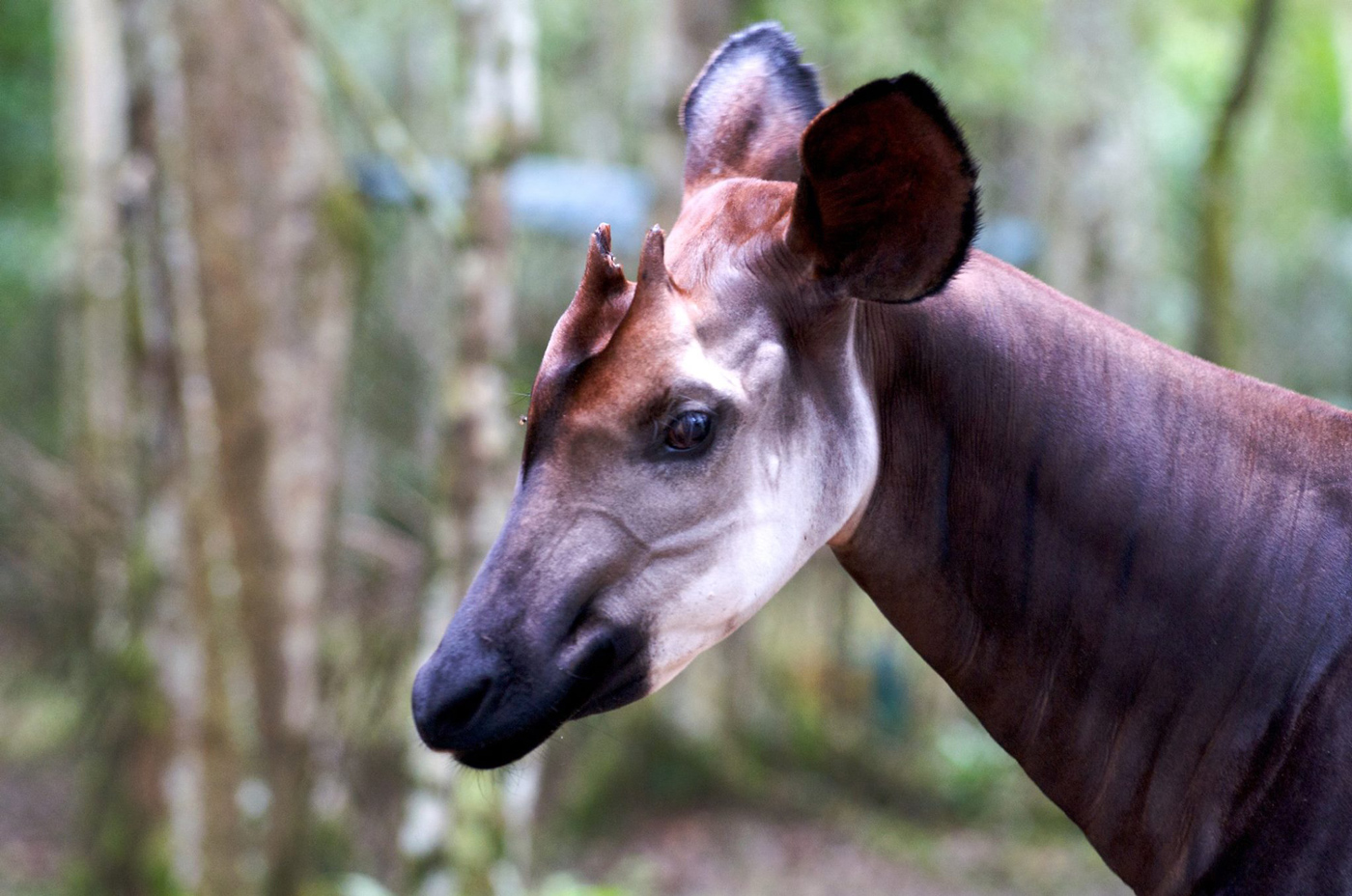
ECOLOGY
Okapi are a shy and gentle species which occur in a wide range of primary and older secondary forest types. They are not found in forest-savannah or disturbed habitats near human beings. Their diet consists solely of understorey foliage from the rainforest trees. They prefer treefall gaps for foraging, where they browse on only the young leaves from more than 100 plant species.
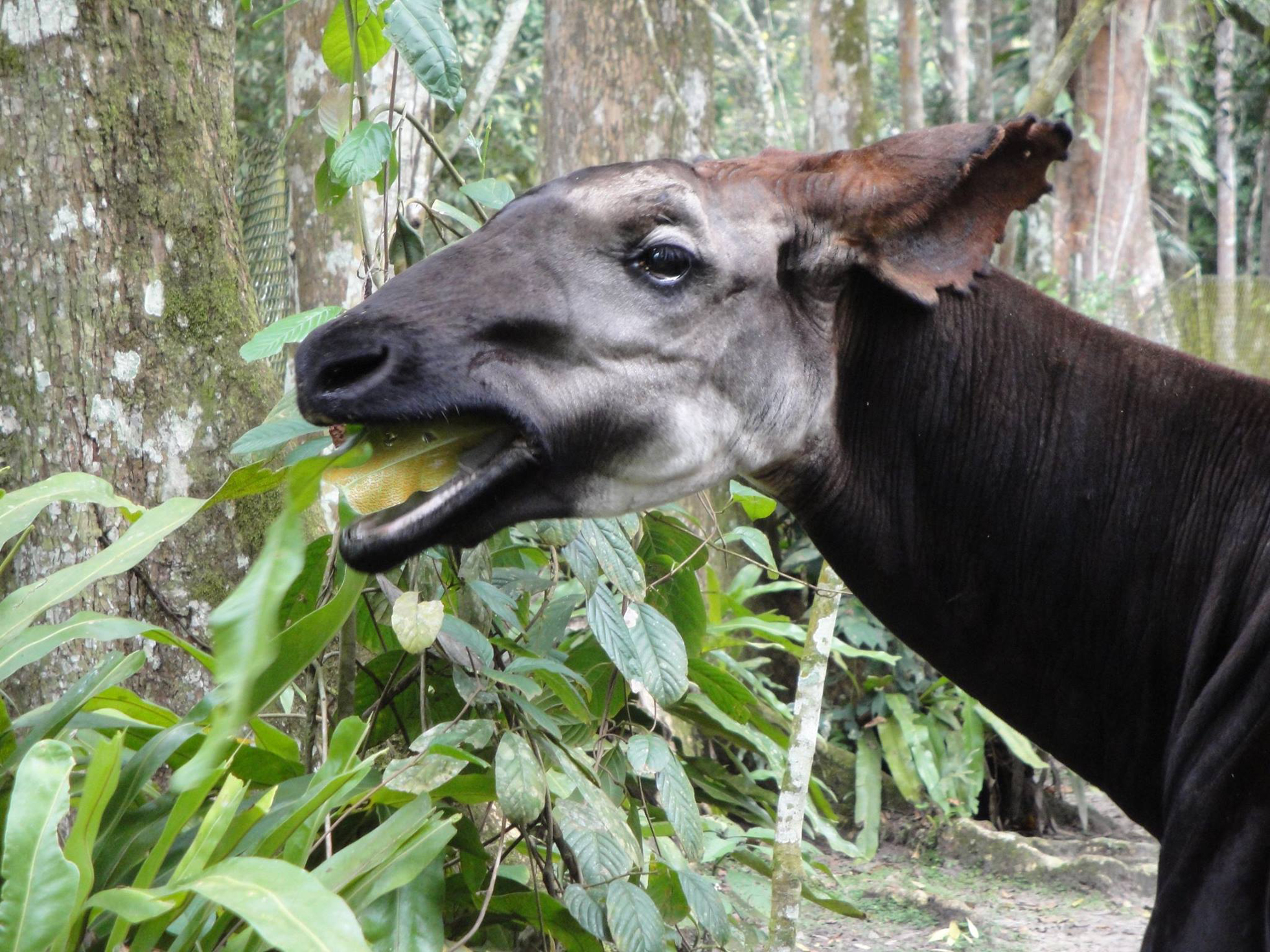
They are mainly diurnal but have also been recorded feeding at night. Okapi are usually solitary, and have well-defined, non-exclusive home ranges, averaging 4-7 km² for adult females and up to 10-17 km² for adult males. Daily movement varies between 2.5 km and 4 km for an adult, often following regular pathways through the trees, a trait that makes them vulnerable to pitfalls and large snare traps.
Okapi are thought to be vulnerable to predation by leopards. Longevity in the wild is unknown, but okapi typically live 15-30 years in captivity, becoming sexually mature at around two years of age.
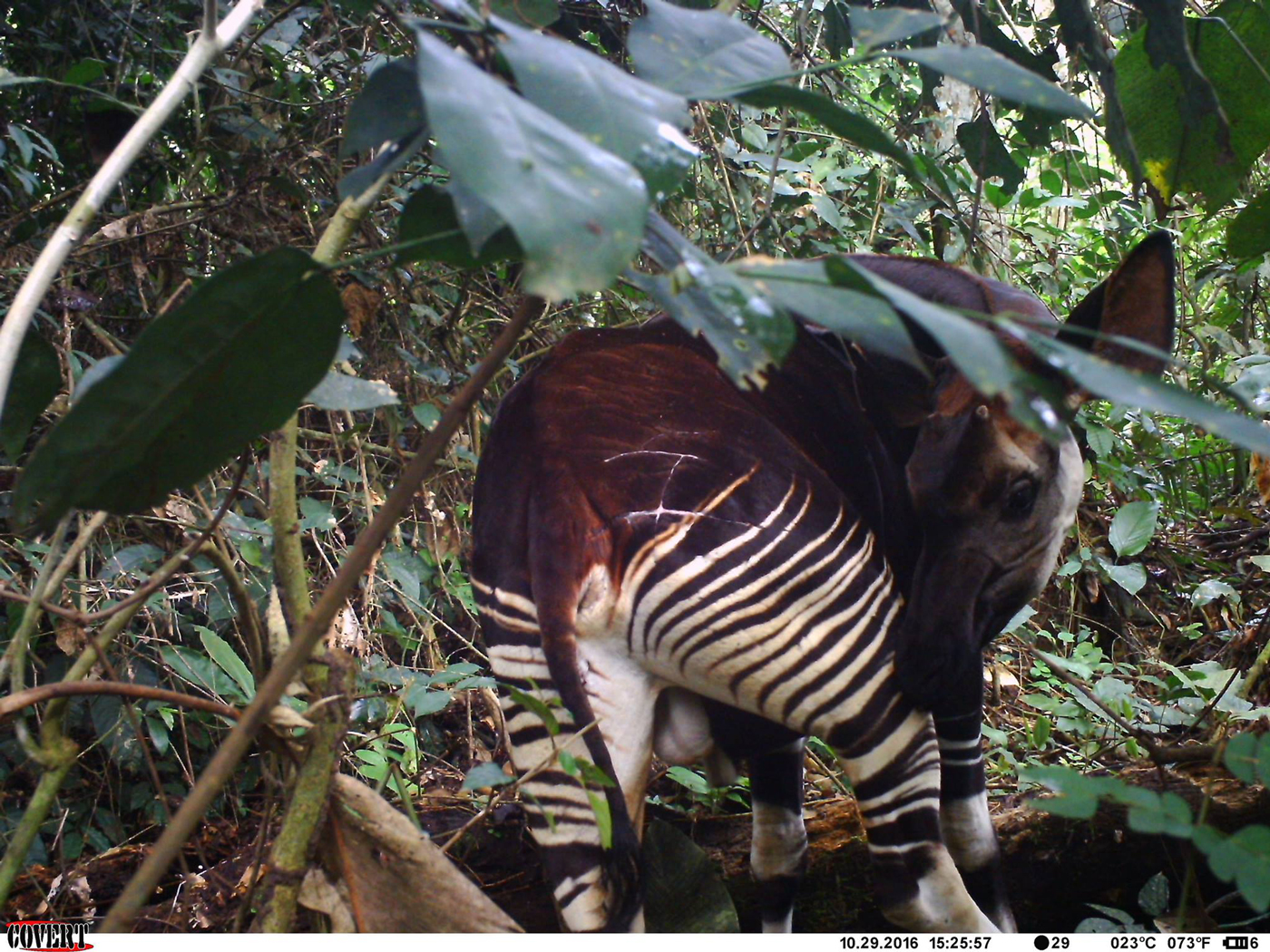
Okapi calves are usually able to stand thirty minutes after birth, but for the first few months of their life spend most of the day hiding while their mothers forage. Infants first defecate 1-2 months after birth, perhaps as an adaptation to reduce the chances of predator detection. One calf tracked by radio-collar was independent at approximately nine months of age.
Preliminary studies indicate that okapi are not highly social animals. While individuals may utilise sections of forest simultaneously, they do not form bonds or tight-knit groups.
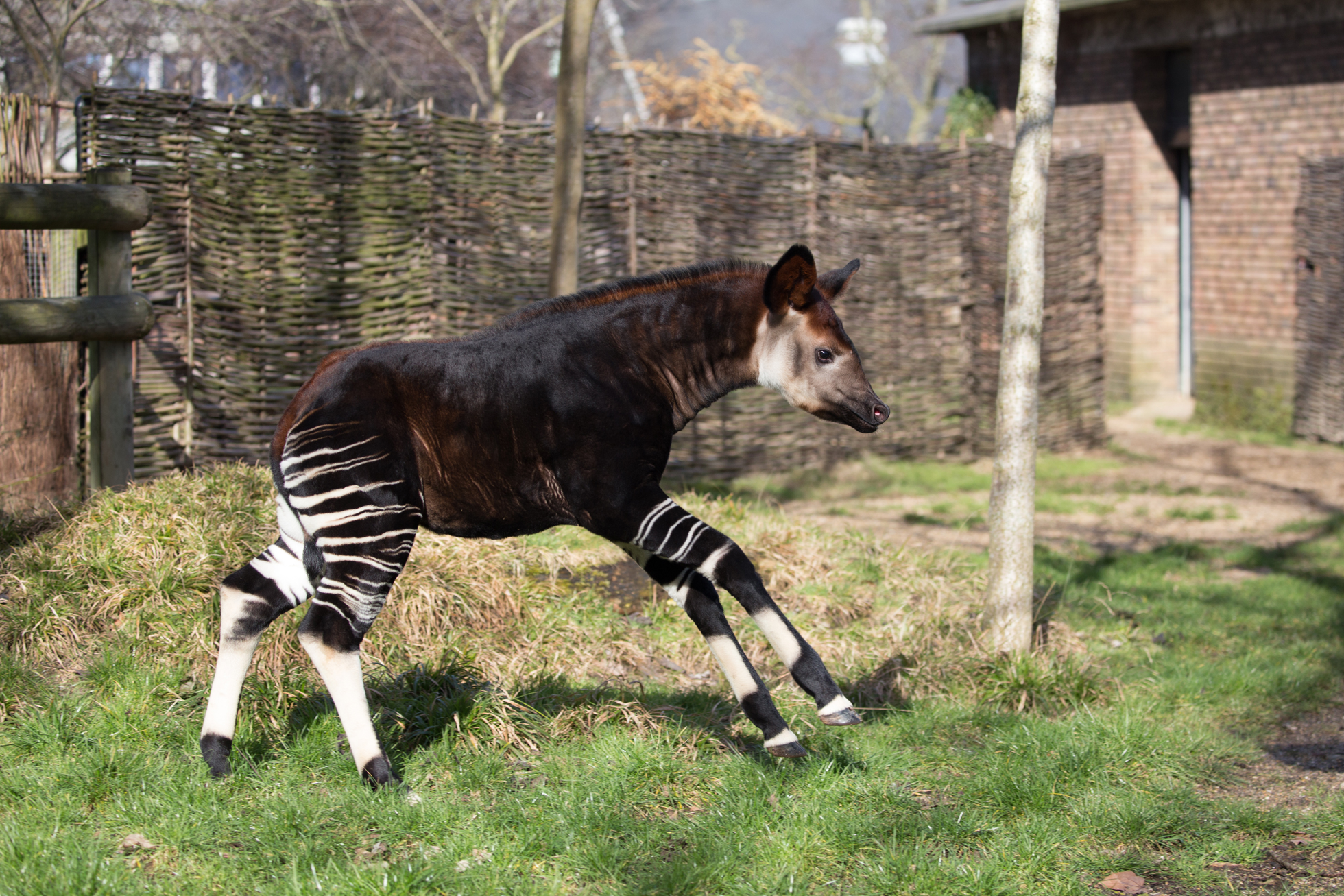
Conservation status
Until late 2013 okapi were classified on the IUCN Red List as ‘Near Threatened’. This was mainly due to a lack of evidence regarding trends in their population.
Studies show a 43% decline within the Okapi Wildlife Reserve between 1995 and 2007, and data from ranger patrols conducted from 2007-2012 suggest this decline may have continued to the present day. In light of this evidence, the okapi has been reclassified as ‘Endangered’ (facing a very high risk of extinction in the wild) on the IUCN Red List. The rate of decline is estimated to have exceeded 50% over three generations (24 years). They face severe, intensifying threats and lack of effective conservation action, and, unless their present rate of decline is halted, extinction is likely.

Range and population
Okapi distribution extends across parts of central, northern and eastern DR Congo. They used to occur occasionally in the adjoining Semliki Forest of western Uganda, where the species is now extinct. The most significant concentrations of okapi occur within the Okapi Wildlife Reserve and Maiko National Park.
Population estimates are not known to any degree of certainty – ranging from ‘over 10,000’ to ‘35,000 to 50,000’. Recorded presence is concentrated in and around protected areas, where surveys are carried out. Much of suitable okapi habitat is poorly studied, due to security concerns, remoteness and inaccessibility.
Additionally, okapi often go undetected because they occur in low densities and are secretive.
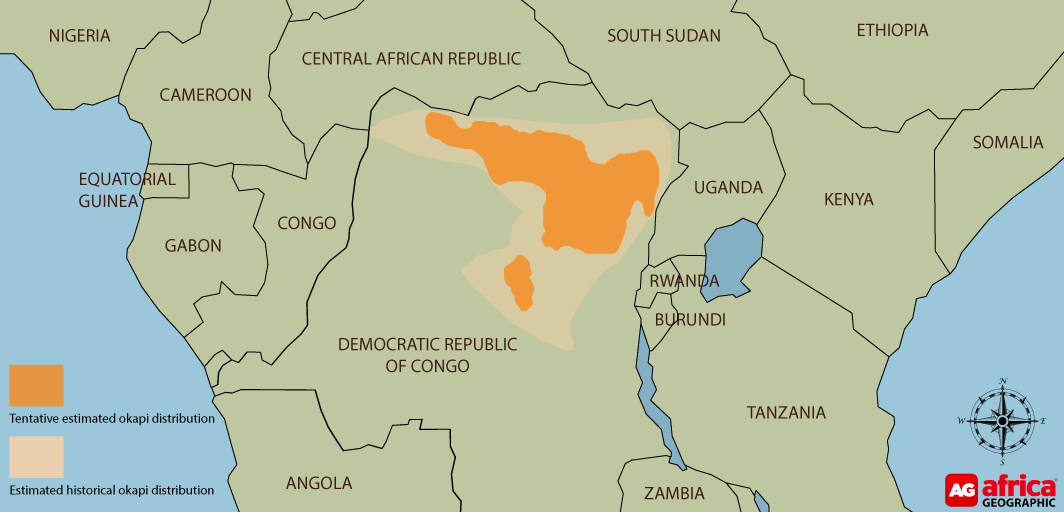
Threats
Expanding human populations, deforestation and forest degradation have eliminated important portions of the okapi range, in particular in the southern and eastern Ituri Forest where the species was at one time abundant. Also, in a small area in the southern part of their range, okapi are hunted for their meat and skin by the locals who consider okapi the most prized bushmeat available.
The most prominent current threat to okapi is the presence of illegal armed groups in and around key protected areas. These groups prevent effective conservation action and monitoring and engage in elephant poaching, bushmeat hunting, illegal mining (gold, coltan and diamonds), illegal logging, charcoal production and agricultural encroachment. In a notorious incident in June 2012, armed rebels attacked the Okapi Wildlife Reserve Epula Station headquarters and killed seven people and all 14 captive okapi – since then no okapis have been brought back to the station.
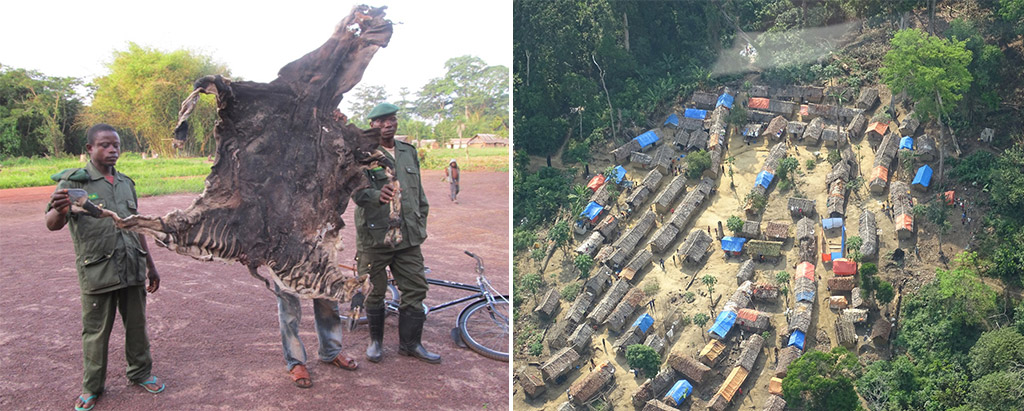
Final word
“The okapi is a curious animal whose reclusive mystery adds to its allure. Solely living in a country that has struggled with insecurity and poverty, but still a vast and varied landscape rich in natural and cultural resources, the okapi maintains itself as a respected symbol of conservation and hope for the future of Congo’s people. We hope that by protecting the peaceful okapi, we can help bring the country’s citizens together to benefit all people and wildlife.” ~ Lucas Meers, Program Officer for Okapi Conservation Project
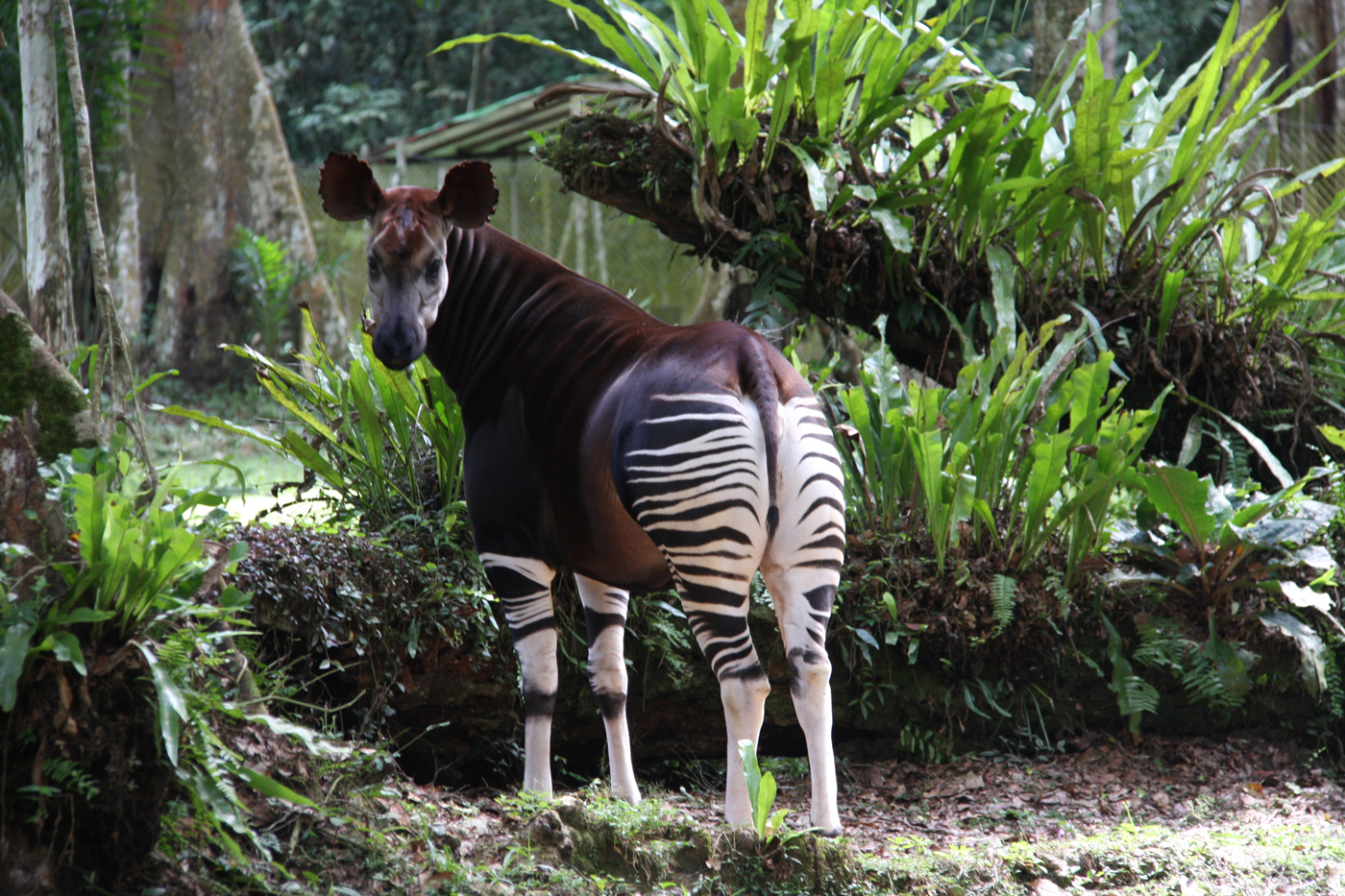
ABOUT THE OKAPI CONSERVATION PROJECT (OCP)
The Okapi Conservation Project was established in DR Congo in June of 1987 when the country was still known as Zaire. The project focusses on three issues: wildlife protection, community assistance and conservation education.
The Okapi Conservation Project works closely with the communities around the reserve and the Institute in Congo for the Conservation of Nature (ICCN) to implement its programs. The OCP assists with coordinating wildlife patrols to remove snares, arrest poachers and close illegal gold mines – thus helping to preserve critical rainforest habitat for threatened species.
During patrols, ICCN rangers document all actions they take to protect wildlife and make a note of any sightings or signs of key wildlife species they encounter, including okapi. Data collected on the number and type of species encountered while on patrol helps develop population estimates of okapi, forest elephants and chimpanzees in the Okapi Wildlife Reserve (OWR).
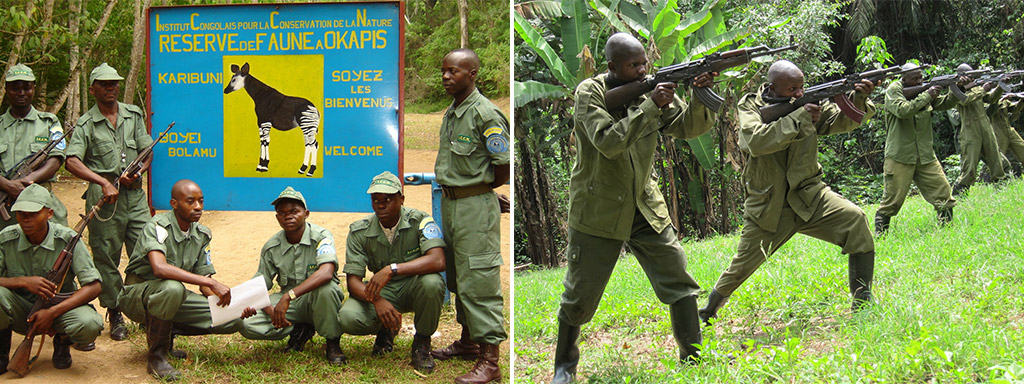
The protection efforts are integral to protecting the okapi and the other imperilled wildlife in the reserve, but this is only possible with the support of the local communities that live alongside wildlife. The OCP manages highly successful programs that reduce negative impacts by residents in the forest.
The Community Assistance programs focus on several key components: agroforestry, women’s groups, pygmy assistance, rebuilding water sources, support for health centres and team sports. The programs aim to create positive relationships with ICCN and provide incentives to protect forest habitat through sustainable resource use. The objective of each program is to improve the financial and food security of families, reducing their reliance on bushmeat and involvement in illegal activities. By providing services, opportunities and training for community members, the OCP has been able to improve the quality of life for the people living in the reserve and reduce their exploitation of natural resources.
Our agroforestry program utilises community demonstration gardens and community tree nurseries to engage community members in cultivation practices that are not only sustainable but also increase crop yield by at least 25%. In communities that have gone through the program, there have not been any clearing of the forest outside of the ICCN designated agricultural zones.
The Women’s Groups show an entrepreneurial spirit, working together to start their own micro-enterprises, such as sewing and gardening, thus producing additional income for their families to improve their houses, pay for school fees and healthcare costs.
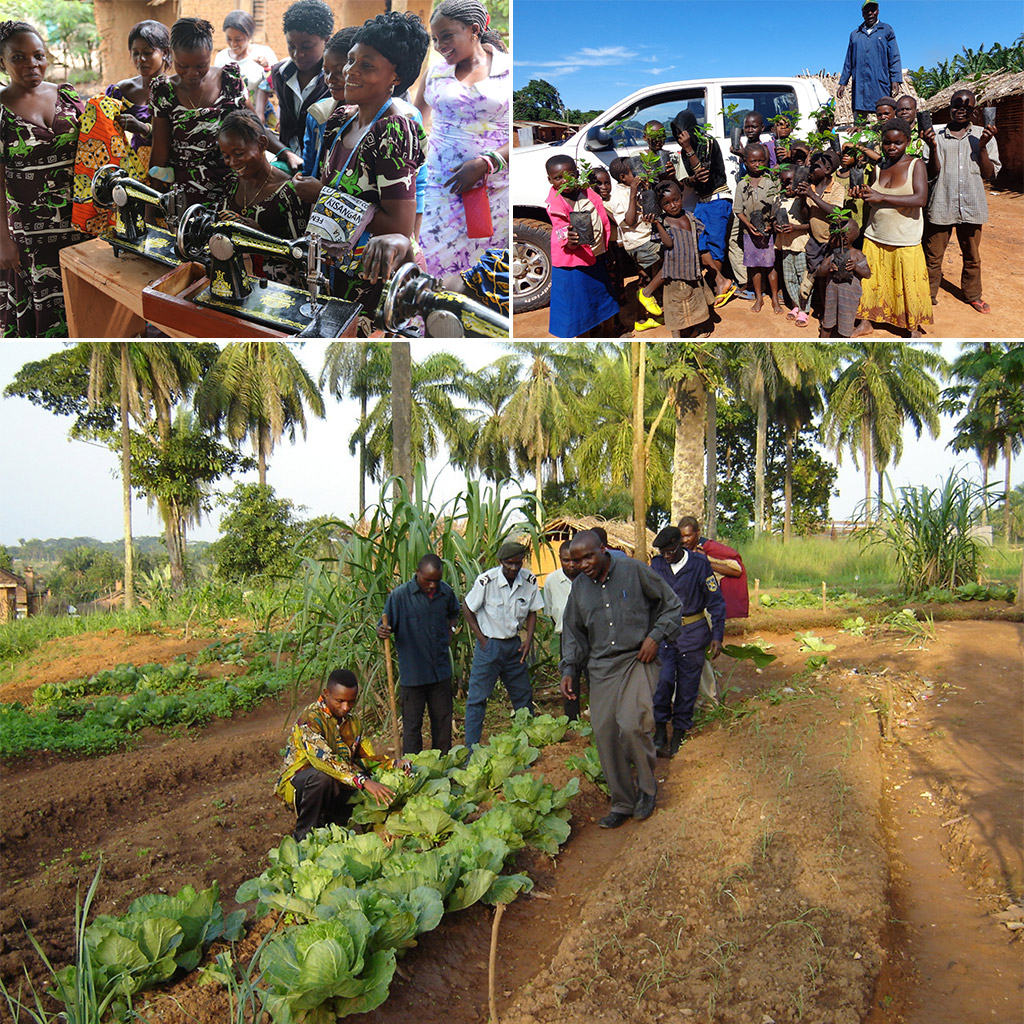
Conservation education is a key component to the OCP’s conservation programs, enlightening communities to the importance of symbiosis with the environment and being active stewards of their natural heritage. Education in the reserve takes several forms; large scale radio broadcasting, informative posters printed in multiple local languages and classroom lessons with secondary students. Schools are provided with educational materials, from posters that identify the local fauna to curriculum that highlights the value of okapi and their associated biodiversity. Students in the reserve are all exposed to okapi and their conservation, to create conservation ambassadors.

The Okapi Conservation Project was the driving force behind the advent of World Okapi Day, celebrated on October 18th each year. Events like World Okapi Day act as informal education opportunities, reaching further into the community and engaging members that are not reached otherwise.
Learn more about the Okapi Conservation Project below (© Okapi Conservation Project)
The IUCN SSC Giraffe and Okapi Specialist Group (GOSG)
The Okapi Conservation Project has been working closely with the Giraffe and Okapi Specialist Group – one of over 120 IUCN SSC Specialist Groups, Red List Authorities and Task Forces working towards achieving the SSC’s vision of “a world that values and conserves present levels of biodiversity”. Made up of experts from around the world, the group leads efforts to study giraffe, okapi and the threats they face, as well as leading and supporting conservation actions designed to ensure the survival of the two species into the future. The Giraffe Conservation Foundation (GCF) and the Zoological Society of London (ZSL) are institutional co-hosts of the GOSG for giraffe and okapi, respectively.
To comment on this story: Login (or sign up) to our app here - it's a troll-free safe place 🙂.![]()




